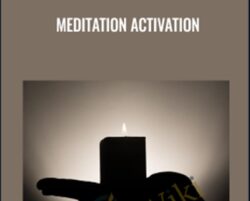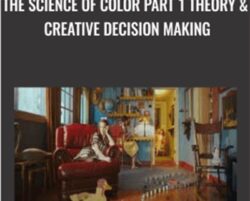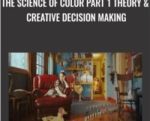KATE WOODMAN TEACHES HOW TO TAKE CONTROL OF COLORIn their quest for better images, photographers often overlook the importance of color. Kate Woodman breaks down the science of color in photography and will show you why you need to make color a driving force behind all of your image making.As photographers, we learn to craft and manipulate light. In its simplest form, color is just another way of seeing light. By taking a scientific approach to color in photography and analyzing the theory behind it and how it affects us, we can take control of color the way we do with light.We can use color in photography to create a better story utilizing emotional cues, enhance our storytelling for the viewer, and invoke emotion to manipulate our audience to feeling a certain way. An essential course for portrait photographers.UNDERSTANDING COLOR IN PHOTOGRAPHYBy understanding color balance, color harmonies and how to manipulate color, Kate will show you how you can control mood and emotion for effective storytelling.In this color photography tutorial Kate Woodman breaks down the science of color to it’s simplest form: light. Kate introduces the basic properties of color like hue, saturation, and luminosity. She then dives into color theory discussing color balance, color harmonies, spacial relationships, and how colors interact in imagery and in the real world.After a in-depth lesson on color in photography and the science behind it, you will see Kate photograph on location and in-studio, objectively planning and utilizing color to create specific emotions in her images. You will then see Kate take her images to post production as a final step in controlling and manipulating color effectively. By the end of the tutorial you will see and understand color like never before. As soon as you start noticing color in photography and in the world, you can take your work to the next level.LESSON OVERVIEW01. COLOR THEORYIntro To Science Of Color (1:47)Join photographer, Kate Woodman, on a journey of color. Explore her interest in relationships, concepts, and ultimately great color work. Conceptualize color theory, through location and studio shooting, and intelligent retouching. Learn the Science of Color and bring intentional vibrance to your photographic portfolio.The Purpose of Color (3:55)Learn the definition of color. Examine it as a wavelength of light and how we perceive the spectrum. Consider the phycological, emotional and even physical responses color can elicit from us. Examine the specific influence of the color blue.Properties of Color (5:13)Expand upon the definition of color by breaking down its individual properties. Define and visualize the properties of hue, saturation, and luminosity. Understand concepts such as tinting, shading, toning, low-key vs high-key imagery. Focus on the interdependent nature of color’s properties to better grasp how color works. Examine the specific influence of the color brown.Color Mixing (3:58)With the definition of color and its 3 main properties, examine the visible spectrum of light in the construct of a color wheel. Compare the RGB and CMYK color models. Define complementary, primary, secondary and tertiary colors. Examine the specific influence of the color green.Color Harmony (4:30)Define and understand the concept of Color Harmony. Visualize color comparing and contrasting monochromatic, complementary, split complementary, double split complementary, triadic, quadratic and analogous harmonies. Examine the specific influence of the color orange.Harmony Example (7:00)After defining and examining some simpler analogies of color – its properties and harmonies, begin to examine photographer, Kate Woodman’s imagery. Test your ability to decipher color harmonies for yourself. Examine the specific influence of the color pink.Color Balance (12:47)Understanding that the theory and science behind color can present complex and abstract concepts, explore a tangible analogy of color harmonies. Observe and visualize the relationship of color utilizing an actual color wheel to explore balance, saturation, harmony and compliment. Examine the specific influence of the color purple.Luminosity Contrast (4:46)With an understanding of color contrast focus on the importance of luminosity contrast. Explore and visualize the relationship between color and luminosity. Examine the dimensional spectrum of color as it relates to luminance. Examine the specific influence of the color red.Perception (6:21)Continue to build on your understanding of color by differentiating brightness versus lightness. Use specific examples from photographer, Kate Woodman, to contextualize brightness and lightness. Explore environmental imagery and see how color communicates weight, orientation, and dimension. Examine the specific influence of the color white.Psychology (4:28)Study the ideas behind Resonance Theory. Begin to connect how we are intimately connected to the frequencies of color around us. Observe specific examples of imagery from photographer, Kate Woodman, to see what kind of emotional responses color can elicit. Examine the specific influence of the color yellow.02. IN STUDIO SHOOTMonochromatic Shoot (17:47)Theory is not very useful without application. Join photographer, Kate Woodman, as she puts the theory of color into practice. Iterate through a series of images as she captures warm, funny and even cheeky moments to realize an in studio photo shoot with the monochromatic color harmony. Focus on putting the theory of color into a practical shooting environment.Split Complementary Shoot (15:50)With a new wardrobe and styling, practice implementing the ideas behind a split complementary color harmony. Produce a series of images to create a practical understanding of this color harmony. Watch as photographer, Kate Woodman, crafts a different narrative with the same in studio setup, by using color relationships as her primary tool.Retouching Introduction (6:03)Having completed the Monochromatic and Split Complementary photoshoots, sit down with photographer Kate Woodman as she retouches her imagery. Cull through the options using Capture One. Learn to see color through her honed and experienced eyes as she examines how color is telling the story through her capture images. After making her selections learn how to prepare the files for retouching in Photoshop.Monochromatic Retouch (9:49)After culling through the first 2 studio shoots, using Capture One, begin retouching an image from the Monochromatic Shoot inside Photoshop. Starting with a simple execution, connect the concepts of hue, saturation, lightness, and luminosity with practical application. Learn to manipulate color within retouching, leveraging Photoshop tools like the hue saturation layer and selective color. Use simple masking along with dodge and burn to create a fun and vibrant image.Split Complementary Retouch (4:31)With an image selected from the Split Complementary shoot, work with photographer Kate Woodman, as she retouches an image that uses a complementary color harmony. Leverage photoshop to control hue and saturation, masking to preserve skin tones, selective color and density. Create a graphic, impactful image using a quadratic color harmony.03. ON LOCATIONOn Location Introduction (2:57)Change focus and move on location with photographer, Kate Woodman, as she develops a highly conceptualized shoot. Follow her as she gives an informative look at her considerations during scouting, casting, styling, lighting and framing a shoot. Connect Kate’s interest in human relationships and their correlation with color and observe as she crafts her story using color theory as the defining undertone of the entire shooting process.Scouting (3:49)Look at scouting a location through the prism of color. Watch as photographer, Kate Woodman, examines an eclectic home and its subsequent details. From flooring to ceiling, wallpaper to furnishings, see how Kate examines a space to develop her creative. See the application of color theory applied to the environment and setting and the ways that can influence styling and wardrobe choices.Casting (3:30)With a concept in mind and a location scouted, examine how photographer, Kate Woodman, approaches casting a shoot for this on location piece. Learn how authenticity, relationships, and even hair color played a role in selecting the mother and 2 sisters as the cast for the shoot.Styling (3:55)Go deeper into understanding why the styling and wardrobe was selected for this American Farm piece. See what Kate selected for styling in wardrobe to work in complement to the location, the timeless aesthetic, the surrounding farm environment and existing color palette of the property.Lighting (3:43)Watch as Kate discusses her thoughts on lighting for this traditional concept, on location shoot. Learn how all of the factors played a role in her decision making on how to light each setup.Framing (11:41)Observe as photographer, Kate Woodman, develops her framing for the on location shoot. Hear her philosophy on using a cinematic approach to framing her stories. Examine her composition and perspective and realize the intention behind all of her choices as they culminate in capturing various scenes throughout the house.Get The Science Of Color Part 1 Theory & Creative Decision Making – Anonymous, Only Price $52Tag: The Science Of Color Part 1 Theory & Creative Decision Making Review. The Science Of Color Part 1 Theory & Creative Decision Making download. The Science Of Color Part 1 Theory & Creative Decision Making discount.
 APA Tools (Oct 2013) – NinjaTrader 7
₹9,130.00
APA Tools (Oct 2013) – NinjaTrader 7
₹9,130.00
 The Art Of Quantum Meditation – Kenji Kumara
₹1,826.00
The Art Of Quantum Meditation – Kenji Kumara
₹1,826.00
The Science Of Color Part 1 Theory & Creative Decision Making
₹7,968.00




